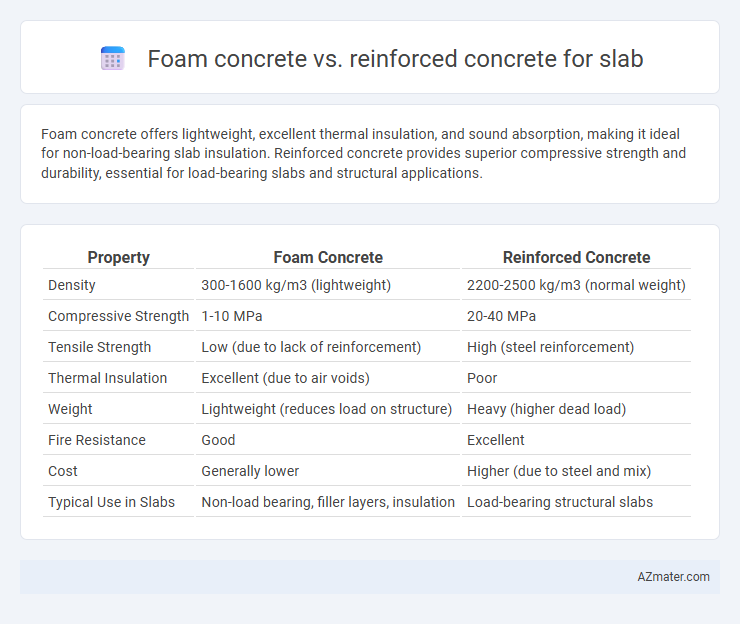Foam concrete offers lightweight, excellent thermal insulation, and sound absorption, making it ideal for non-load-bearing slab insulation. Reinforced concrete provides superior compressive strength and durability, essential for load-bearing slabs and structural applications.
Table of Comparison
| Property | Foam Concrete | Reinforced Concrete |
|---|---|---|
| Density | 300-1600 kg/m3 (lightweight) | 2200-2500 kg/m3 (normal weight) |
| Compressive Strength | 1-10 MPa | 20-40 MPa |
| Tensile Strength | Low (due to lack of reinforcement) | High (steel reinforcement) |
| Thermal Insulation | Excellent (due to air voids) | Poor |
| Weight | Lightweight (reduces load on structure) | Heavy (higher dead load) |
| Fire Resistance | Good | Excellent |
| Cost | Generally lower | Higher (due to steel and mix) |
| Typical Use in Slabs | Non-load bearing, filler layers, insulation | Load-bearing structural slabs |
Introduction to Foam Concrete and Reinforced Concrete
Foam concrete is a lightweight, low-density material made by mixing cement, water, and foam, offering excellent thermal insulation and reduced dead load for slabs. Reinforced concrete consists of standard concrete combined with steel reinforcement bars, providing superior tensile strength and structural durability for slabs. Choosing between foam concrete and reinforced concrete depends on project requirements such as load-bearing capacity, insulation needs, and cost efficiency.
Composition and Material Properties
Foam concrete consists of cement, water, and a foam agent that creates air bubbles, resulting in a lightweight, low-density material with excellent thermal insulation and reduced dead load. Reinforced concrete combines concrete with steel rebar to enhance tensile strength, offering superior durability, load-bearing capacity, and resistance to cracking under tension. The high compressive strength of reinforced concrete contrasts with the insulating and lightweight advantages of foam concrete, making each material suitable for different slab design requirements.
Structural Strength Comparison
Foam concrete exhibits lower compressive strength, typically ranging from 3 to 8 MPa, compared to reinforced concrete slabs which can exceed 30 MPa due to embedded steel reinforcement providing high tensile and flexural strength. Reinforced concrete slabs are preferred for structural applications demanding durability and load-bearing capacity, offering superior performance under bending and shear stresses. Foam concrete, while lightweight and thermally insulating, lacks the structural integrity required for primary slab support in most construction projects.
Weight and Density Differences
Foam concrete has a significantly lower density, typically ranging from 300 to 1600 kg/m3, compared to reinforced concrete, which generally weighs around 2400 kg/m3. This reduced weight makes foam concrete advantageous for slab applications where load reduction is critical, such as in high-rise buildings or weak soil conditions. Reinforced concrete slabs, due to their higher density and strength from steel reinforcement, offer superior load-bearing capacity but result in increased structural weight.
Thermal and Acoustic Insulation
Foam concrete provides superior thermal insulation due to its lightweight, porous structure that traps air and reduces heat transfer, making it ideal for energy-efficient slabs. Reinforced concrete, while stronger and more durable for load-bearing applications, offers minimal thermal insulation because of its dense composition. Acoustic insulation is enhanced in foam concrete slabs as the air pockets absorb sound waves, whereas reinforced concrete tends to reflect sound, resulting in poorer noise reduction.
Fire Resistance and Durability
Foam concrete offers superior fire resistance due to its low thermal conductivity and non-combustible nature, making it ideal for slabs requiring high fire safety. Reinforced concrete, while structurally stronger and more durable under mechanical stress, can suffer from spalling and degradation under extreme heat unless properly treated. Long-term durability of foam concrete slabs depends on proper curing and protection from moisture, whereas reinforced concrete slabs benefit from corrosion-resistant reinforcement to maintain structural integrity over time.
Ease of Construction and Application
Foam concrete offers superior ease of construction for slabs due to its lightweight nature, allowing faster placement and reduced formwork requirements compared to reinforced concrete. Reinforced concrete slabs demand skilled labor for steel reinforcement placement and curing, increasing construction complexity and time. The low-density foam concrete enhances workability and thermal insulation, making it suitable for non-structural slab applications where speed and ease of installation are priorities.
Cost Analysis and Economic Factors
Foam concrete offers significant cost savings over reinforced concrete for slabs due to its lightweight nature, reducing transportation and labor expenses. Its lower material density decreases the need for heavy reinforcement and foundation work, directly impacting overall project budgets. While reinforced concrete provides superior structural strength, foam concrete's economic benefits make it an attractive option for non-load-bearing slabs and applications prioritizing cost efficiency.
Sustainability and Environmental Impact
Foam concrete offers superior sustainability benefits over reinforced concrete due to its lightweight composition, which reduces material usage and lowers carbon emissions during transportation and installation. Reinforced concrete generates higher environmental impacts because of the extensive cement and steel required, resulting in increased energy consumption and CO2 emissions during production. Foam concrete's enhanced insulation properties also contribute to energy efficiency in buildings, decreasing overall operational carbon footprints compared to traditional reinforced concrete slabs.
Best Use Cases for Slab Construction
Foam concrete is best suited for lightweight slab applications requiring excellent thermal insulation and reduced dead load, such as in non-structural flooring and roof slabs. Reinforced concrete slabs excel in structural strength and durability, making them ideal for load-bearing floors, bridges, and high-stress industrial slabs. Choosing between foam concrete and reinforced concrete depends on specific project requirements, including load capacity, insulation needs, and construction cost.

Infographic: Foam concrete vs Reinforced concrete for Slab
 azmater.com
azmater.com